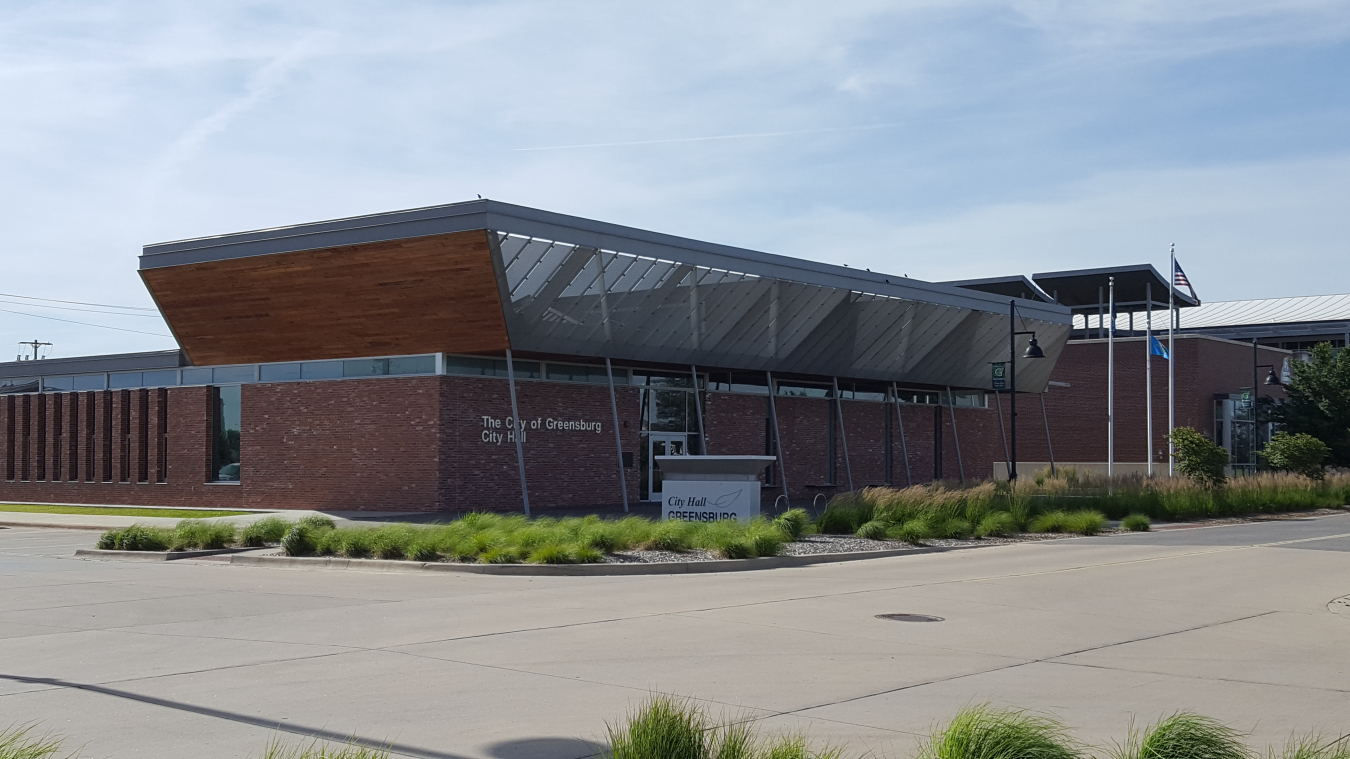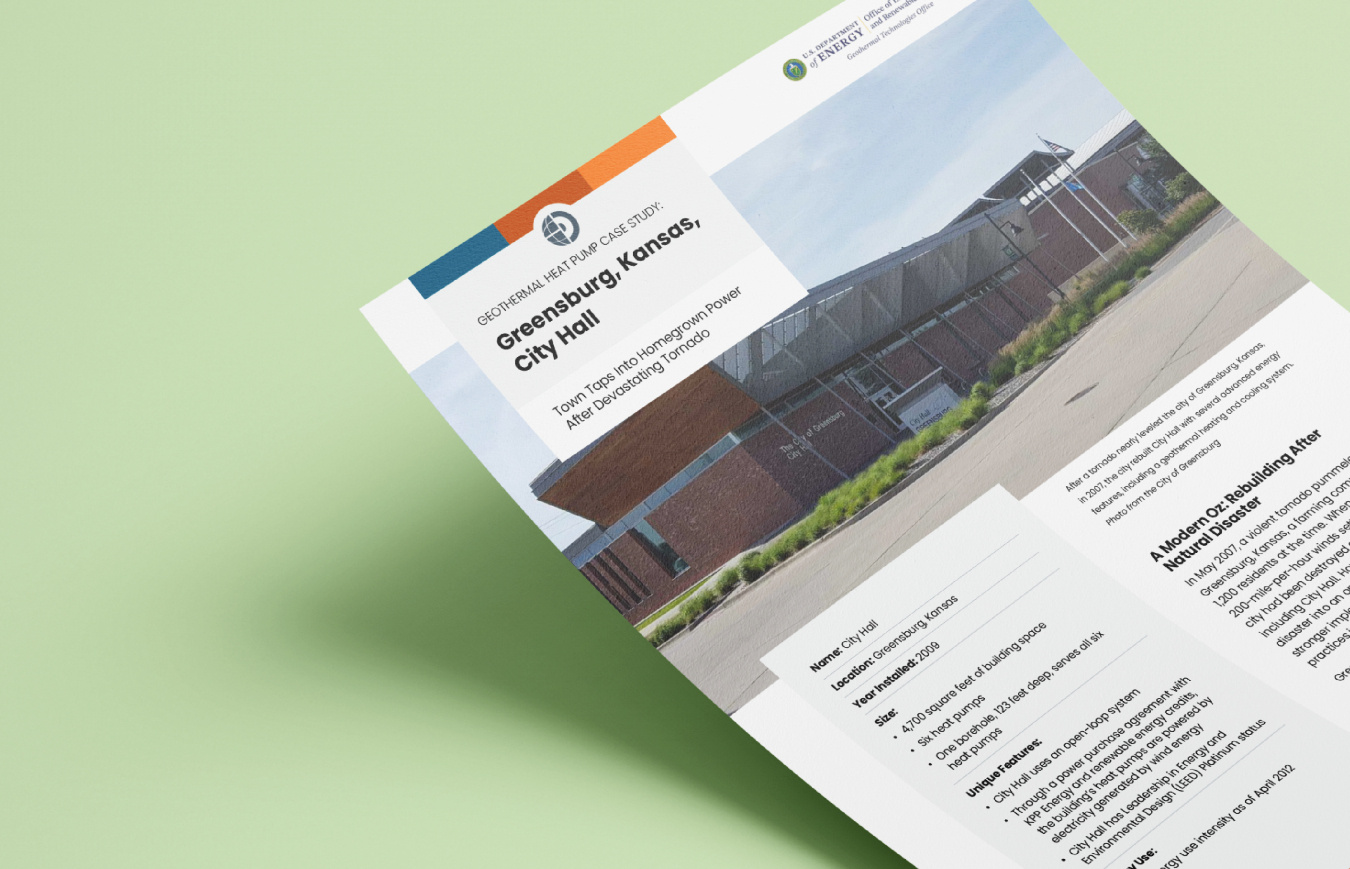
After a tornado nearly leveled the city of Greensburg, Kansas, in 2007, the city rebuilt City Hall with several advanced energy features, including a geothermal heating and cooling system. Photo from the City of Greensburg
Fast Facts
Location: Greensburg, Kansas
Size:
- 4,700 square feet of building space
- Six heat pumps
- One borehole, 123 feet deep, serves all six heat pumps
Download the full case study for additional fast facts.
A Modern Oz: Rebuilding After Natural Disaster
In May 2007, a violent tornado pummeled Greensburg, Kansas, a farming community of 1,200 residents at the time. When the tornado’s 200-mile-per-hour winds settled, 95% of the city had been destroyed or severely damaged—including City Hall. However, Greensburg turned this disaster into an opportunity to rebuild better and stronger implementing innovative, energy-efficient practices in new and reconstructed buildings.
Greensburg’s new City Hall is one of these better, stronger buildings. Rebuilt between 2008 and 2009 to LEED Platinum standards, the 4,700-square foot building boasts an open-loop, vertical geothermal system, which heats and cools the building’s council chambers, administrative offices, and gathering spaces.
Lessons and Learning Curves
City Hall’s open-loop geothermal system—the only open-loop system in town—pumps groundwater up from a well, uses the water to transfer heat to or from the building, and then discharges the water back into the ground. Other Greensburg buildings, including the hospital, county courthouse, sheriff’s office, and K-12 school, have closed-loop geothermal systems, which transfer heat by circulating fluid through a closed network of pipes buried in the ground without any groundwater being added or removed.
The city chose the open-loop system because it was the most affordable. In addition, open-loop geothermal systems can be more efficient and cost-effective, simpler to install, and require less land. However, the open-loop system had its maintenance challenges. When it was installed in 2009, not many heating, ventilating, and air-conditioning contractors in the area had experience working on a geothermal system, nor did Greensburg municipal building staff.
Greensburg City Hall’s geothermal heat pump system is a key part of the building’s efficiency measures, which also include rooftop solar panels. Photo from the City of Greensburg
Unique Features:
- City Hall uses an open-loop system
- Through a power purchase agreement with KPP Energy and renewable energy credits, the building’s heat pumps are powered by electricity generated by wind energy
- City Hall has Leadership in Energy and Environmental Design (LEED) Platinum status
Energy Use:
41.4 energy use intensity as of April 2012
However, today, geothermal heat pump (GHP) systems are more common, and more contractors know how to maintain and repair them. The city also trained building staff on the system’s day-to-day upkeep and to be familiar enough with the system to know what needs to be fixed when issues arise. Overall, Greensburg’s city officials have been satisfied with City Hall’s geothermal system.
“In our specific case, even though we’ve experienced some challenges with our open-loop system, it has still been energy-efficient and worthwhile,” said Greensburg City Administrator Stacy Barnes.
From Post-Cyclone Ruins to Emerald City
The 2007 tornado was devastating, but it came with a silver lining: It gave the city a chance to design a new building with features that will make the building healthy, comfortable, and efficient well into the future. Greensburg City Hall’s geothermal system is just one of the building’s several advanced energy features. Humidity sensors prompt the building’s geothermal heat pumps to slow fan speeds and dehumidify the building, windows and skylights maximize sunlight and reduce the building’s electricity consumption.
Beyond City Hall, low-flow fixtures, native plantings, and rainwater collection systems minimize Greensburg’s water consumption. Wind—the same force of nature that nearly wiped the city off the map in 2007—now provides all of Greensburg’s electricity. Thanks in part to its adoption of geothermal and these other energy-efficient practices, Greensburg has become a model for one way communities can recover from disasters.
“The City of Greensburg is very pleased with the geothermal heat pumps we have deployed in our City Hall and other municipal facilities. Their reliability and efficiency have saved the city tens of thousands of dollars in energy costs over the past 15 years, and we expect them to continue to pay dividends for the city and its residents for many years to come.”
Matt Christenson, Mayor, City of Greensburg
Contacts:
For questions about this case study, contact Matt Christenson, mayor@greensburgks.org.
For any website technical issues or general questions about geothermal heat pumps, contact DOE.Geothermal@ee.doe.gov.
Printable Version
Download the printable Greensburg City Hall case study or visit the Geothermal Heat Pump Case Studies page to see more examples of geothermal heat pumps in action.


